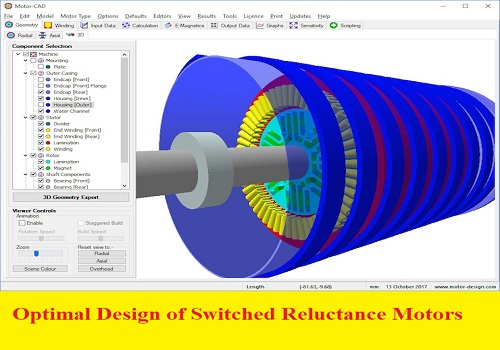Admin
مدير المنتدى


عدد المساهمات : 18992
التقييم : 35482
تاريخ التسجيل : 01/07/2009
الدولة : مصر
العمل : مدير منتدى هندسة الإنتاج والتصميم الميكانيكى
 |  موضوع: بحث بعنوان Optimal Design of Switched Reluctance Motors موضوع: بحث بعنوان Optimal Design of Switched Reluctance Motors  الأحد 22 مايو 2022, 1:29 am الأحد 22 مايو 2022, 1:29 am | |
| 
أخواني في الله
أحضرت لكم
بحث بعنوان
Optimal Design of Switched Reluctance Motors
T. J. E. Miller, Fellow, IEEE

و المحتوى كما يلي :
Abstract—The fundamental theory of the switched reluctance
motor is presented with a number of new equations. It is used to
show how the practical development of a design calculation should
proceed, and this leads to a discussion of physical characteristics
required to achieve satisfactory performance and to reduce
acoustic noise. The paper makes a few generic observations on the
characteristics of successful products that use switched reluctance
motors. It is written at a basic engineering level and makes no
attempt to apply sophisticated optimization theory.
Index Terms—Electric motors, switched reluctance motors.
Stator pole arc.
Rotor slot depth.
Stroke angle.
Phase electromotive force (EMF), V.
End-effect parameter.
End-effect parameter.
Phase resistance, .
Phase current, A.
End-winding inductance.
Unaligned inductance.
Unaligned inductance (two-dimensional value).
Stack length, mm.
Number of phases.
Number of rotor poles.
Number of stator poles.
Absolute overlap ratio.
Effective overlap ratio.
Number of strokes per revolution.
Time, s.
Electromagnetic torque.
Absolute torque zone.
Effective torque zone.
Terminal voltage of the phase winding, V.
Angular velocity, rad/s.
Phase flux-linkage, V s.
Rotor position, rad
CONCLUSION
As with most engineered products, the “optimal” design of
switched reluctance motors is a matter of compromise involving
many parameters. The switched reluctance motor is now mature
enough to have proved itself in the marketplace in a few different
applications. The number and range of these applications remain
small compared with those of induction motors or even brushless permanent-magnet motors, but it can be argued that this is
partly a consequence of the level of investment and tooling in
these technologies, rather than a result of inherent technical deficiencies in the switched reluctance motor itself. Even its widely
criticized “noise problem” has not prevented successful commercial applications.
There is, however, a technical impediment to the development
of switched reluctance motors in the unfamiliarity of the necessary design procedures, not only for the motor but also for the
control. It is self-evident that the technology of induction motor
drives, for example, while no less sophisticated than that of the
switched reluctance motor drive, is much better established and
more widely accepted and is supported by a vast infrastructure
of component supplies and all the other factors which go into
successful businesses. This paper shows that the mathematical
design theory of the switched reluctance motor is simple on
paper but difficult to implement in practice, requiring computer
methods for even the simplest design calculations. Moreover,
the mathematical theory does not suggest a natural architecture
for the innermost feedforward control (the relationship between
torque and current, the choice of firing angles and the criteria
for controlling the sharing of torque between phases).
During the last 30 years, in parallel with the attempt to bring
the switched reluctance motor into widespread commercial production, great strides have been made in competing technologies. We have seen spectacular developments in the properties
and commercial supply of permanent magnet materials; many
detailed improvements in induction motors; and huge strides in
the size, reliability, cost, and performance of ac drives. All these
set the switched reluctance motor even further behind, making
it likely that future successful applications will follow the pattern of those already established: in other words, a highly engineered specialty drive whose development cost must be borne
by the application and whose unique features render it the best
choice. If you have got one of these, go for it!
What is necessary to develop a successful switched reluctance
motor drive is a combination of intensive computation including
electromagnetic, mechanical, and electronic design, then, a significant phase of laboratory testing and, finally, a suitable investment in tooling. The controller will be specific for each application. The process requires the abandonment of traditional
thinking about sinewaves, space vectors, field orientation, and
so on; instead, one must work with computed numerical data
whose structure is not easily discernible. The level of acceptability in the market also remains an issue, although the successful pioneering applications show how this can be overcome.
كلمة سر فك الضغط : books-world.net
The Unzip Password : books-world.net
أتمنى أن تستفيدوا من محتوى الموضوع وأن ينال إعجابكم
رابط من موقع عالم الكتب لتنزيل بحث بعنوان Optimal Design of Switched Reluctance Motors
رابط مباشر لتنزيل بحث بعنوان Optimal Design of Switched Reluctance Motors 
|
|







